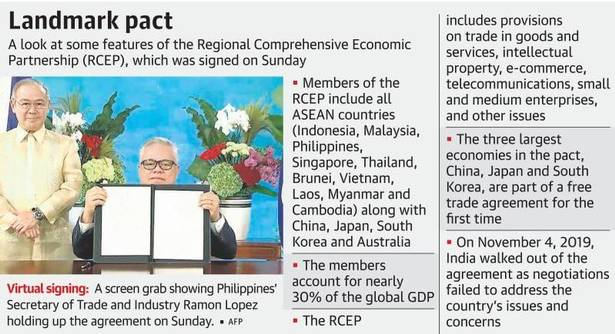
In New
Recently, Singapore has ratified the Regional Comprehensive Economic Partnership (RCEP) agreement becoming the first participating country to do so.
- At the 6th edition of the Raisina Dialogue, Singapore’s Foreign Minister has expressed hopes on India reassessing its stand on regional trade pacts like the RCEP and the Comprehensive and Progressive Agreement for Trans-Pacific Partnership (CPTPP).
About RCEP
- Background: In 2012, the RCEP negotiations were launched by 10 ASEAN Member States and 6 ASEAN Free Trade Agreement (FTA) partners during the 21st ASEAN Summit and Related Summits in Phnom Penh, Cambodia.
- ASEAN Members: Brunei Darussalam, Cambodia, Indonesia, Lao PDR, Malaysia, Myanmar, the Philippines, Singapore, Thailand and Vietnam.
- FTA Partners: Australia, People’s Republic of China, India, Japan, Republic of Korea and New Zealand.
- Objective: To achieve a modern, comprehensive, high-quality, and mutually beneficial economic partnership agreement among the ASEAN Member States and ASEAN’s FTA partners.
- The negotiations commenced in early 2013 and India withdrew from the agreement in November 2019 as negotiations failed to address its outstanding issues and concerns.
- It was signed by the remaining 15 participating countries in November 2020 and will enter into force after six ASEAN member states and three ASEAN FTA partners have ratified it.
- The participating countries are targeting entry into force on 1st January 2022.
- It comprises about 30 per cent of global Gross Domestic Product (GDP) and close to a third of the world’s population.
- Coverage Areas
- Trade in goods and services, investment, economic and technical cooperation, intellectual property, competition, dispute settlement, e-commerce, small and medium enterprises (SMEs) and other issues.
- Significance
- The RCEP is a major step forward for the world, at a time when multilateralism is losing ground and global growth is slowing.
- It is committed to providing fair regional economic policies that mutually benefit both the ASEAN and its FTA partners.
- It has the potential to deliver significant opportunities for businesses in the East Asia region.
- It will provide a framework aimed at lowering trade barriers and securing improved market access for goods and services for businesses in the region.
- Ratification by Singapore will complement its existing network of FTAs and boost trade and investment flows.

Reasons for India’s Withdrawal
- India had been consistently raising fundamental issues and concerns throughout the negotiations and was prompted to take this stand as they had not been resolved by the deadline to commit to signing the deal.
- Safeguard the Interests of Industries
- Its decision was to safeguard the interests of industries like agriculture and dairy and to give an advantage to the country’s services sector.
- Escalating Tensions with China
- While China’s participation in the deal had already been proving difficult for India due to various economic threats, the clash at Galwan Valley has soured relations between the two countries.
- The various measures taken by India to reduce its exposure to China would have not matched with its commitments under RCEP.
- Most-Favoured-Nation (MFN) Obligations
- India wanted RCEP to exclude MFN obligations from the investment chapter, as it did not want to hand out, especially to countries with which it has border disputes.
- India felt that the agreement would force it to extend benefits to other countries for sensitive sectors like defence, etc.
- Trade Deficits
- India has trade deficits with 11 of the 15 RCEP countries and some experts feel that India has been unable to leverage its existing bilateral FTAs with RCEP members to increase exports.
- Other Concerns
- India’s decision would impact its bilateral trade ties with RCEP member nations, as they may be more inclined to focus on bolstering economic ties within the bloc.
- The move could potentially leave India with less scope to tap the large market that RCEP presents.
- Safeguard the Interests of Industries
Singapore on India Joining RCEP
- The US-China tensions are worrying for the region with the ongoing pandemic resulting in heightened tensions.
- These issues have implications for all of the regional players with a contest over emerging technologies, divergence on human rights and tensions related to defence and cybersecurity issues.
- In Southeast Asia, it is all the more crucial to maintain ASEAN centrality and unify amid geopolitical competition.
- Singapore hopes that India can play a crucial role to help build a regional architecture that is ‘open’ and ‘inclusive’ and wants India to reassess regional trade pacts like the RCEP and the Comprehensive and Progressive Agreement for Trans-Pacific Partnership (CPTPP).
- These trade pacts will give Indian companies a platform to showcase their strengths across even larger markets.
|
Comprehensive and Progressive Agreement for Trans-Pacific Partnership
|
Previous article
Multisystem Inflammatory Syndrome in Children (MIS-C)
Next article
Vaccine Nationalism